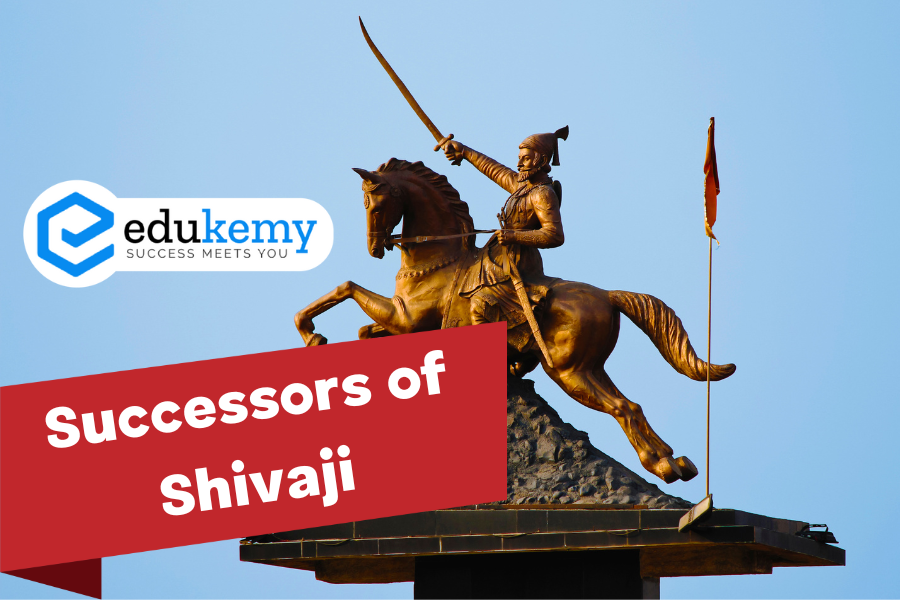
The successors of Shivaji, the founder of the Maratha Empire, played pivotal roles in shaping the destiny of this powerful kingdom in the 17th century. After Shivaji died in 1680, his eldest son, Sambhaji, ascended to the throne. Sambhaji faced numerous challenges, including conflicts with the Mughals and internal dissensions within the Maratha ranks. Despite his valiant efforts, Sambhaji was captured and executed by the Mughals in 1689. Following his demise, Shivaji’s younger son, Rajaram, assumed leadership and continued the resistance against the Mughals. Rajaram’s reign was marked by strategic retreats, guerrilla warfare, and a resilient spirit. His wife, Tarabai, also made significant contributions to the Maratha cause during his reign and after he died in 1700. The legacy of Shivaji’s successors endured through subsequent generations, with each ruler contributing to the expansion and consolidation of the Maratha Empire. The challenges they faced, their military prowess, and their diplomatic acumen collectively shaped the course of Maratha’s history, leaving a lasting impact on the political landscape of India.
Contents
- 1 Frequently Asked Questions (FAQs)
- 1.1 Q: Who were the successors of Shivaji?
- 1.2 Q: What challenges did the successors of Shivaji face?
- 1.3 Q: How did the successors contribute to the expansion of the Maratha Empire?
- 1.4 Q: What were the diplomatic relations like for the successors of Shivaji?
- 1.5 Q: How did the administration and governance evolve under the successors of Shivaji?
- 2 In case you still have your doubts, contact us on 9811333901.
Shambhaji (1680-1689):
He was the son and successor of Shivaji who continued the anti-Mughal policy of his father. Shambhaji provided asylum to Prince Akbar, the revolting son of Aurangzeb in 1681. Aurangzeb came to Deccan and spent 26 long years at Aurangabad fighting with Marathas. In 1689, Shambaji was killed by the Mughal general, Mukharab Khan in the Battle of Sangameswar. Sahu, the minor son of Shambhaji was taken as a captive to Delhi and imprisoned for 18 years.
Rajaram (1689-1700):
He was another son of Shivaji and the successor of his brother Shambaji. He fought against Aurangzeb through guerrilla warfare. He strategically shifted his capital from Raigad to Gingee and later from Gingee to Satara.
Tarabai (1700-1707):
She was the wife of Rajaram. She made her minor son, Shivaji-II as the king and ruled herself as the regent. Under her leadership, Marathas continued their plundering raids on Mughal territories through guerrilla warfare methods.
Sahu (1707-1749):
He lived in Delhi as a prisoner of the Mughals from 1689 to 1707. The Mughal emperor Bahadur Shah-1 set him free and recognized him as the Chatrapati. As he was an incompetent ruler, his Peshwas retained all powers and became the de-facto ruler. In 1749, Sahu died leaving no successors and the lineage of Shivaji came to an end. Thereafter the Maratha kingdom went into the hands of the Peshwas.
Read our ALL MEDIEVAL HISTORY NOTES.
Frequently Asked Questions (FAQs)
Q: Who were the successors of Shivaji?
A: Shivaji’s successors included his eldest son, Sambhaji, who succeeded him as the second Chhatrapati of the Maratha Empire. After Sambhaji, his younger brother, Rajaram, took over the throne. The line of succession continued through various rulers, with notable figures such as Shivaji II and Shahu Maharaj playing significant roles in the later years.
Q: What challenges did the successors of Shivaji face?
A: The successors of Shivaji faced numerous challenges, including external invasions by the Mughals and other regional powers. Internal conflicts and power struggles within the Maratha leadership also posed significant threats. Sambhaji, in particular, had a tumultuous reign marked by conflicts with the Mughals, which eventually led to his execution.
Q: How did the successors contribute to the expansion of the Maratha Empire?
A: Despite facing challenges, some of Shivaji’s successors played key roles in expanding the Maratha Empire. Rajaram, for example, continued the resistance against Mughal forces and laid the foundation for further territorial gains. Later rulers, such as Shahu Maharaj, contributed to the consolidation and expansion of the Maratha Empire in different regions of India.
Q: What were the diplomatic relations like for the successors of Shivaji?
A: The successors of Shivaji engaged in complex diplomatic relations with various neighboring states. They often formed alliances with regional powers to counter external threats, and at times, they faced internal divisions due to conflicting interests among Maratha chieftains. Understanding the diplomatic intricacies during the rule of Shivaji’s successors is crucial to comprehending the geopolitical landscape of that period.
Q: How did the administration and governance evolve under the successors of Shivaji?
A: The administrative and governance structures initiated by Shivaji underwent changes and refinements during the rule of his successors. Efforts were made to streamline and strengthen the administrative machinery of the Maratha Empire. Understanding the administrative reforms and governance policies implemented by Shivaji’s successors provides insights into the dynasty’s ability to adapt to the evolving political landscape.
In case you still have your doubts, contact us on 9811333901.
For UPSC Prelims Resources, Click here
For Daily Updates and Study Material:
Join our Telegram Channel – Edukemy for IAS
- 1. Learn through Videos – here
- 2. Be Exam Ready by Practicing Daily MCQs – here
- 3. Daily Newsletter – Get all your Current Affairs Covered – here
- 4. Mains Answer Writing Practice – here

